Asana is one of the best free project management software options for organizing and managing your workflows, tasks and projects. If you’re new to Asana, this Asana tutorial will help you understand some of its most important basic features.
Asana provides a variety of views, such as lists, boards and timelines, which allow you to see your tasks in different ways. By the end of this tutorial, you’ll understand all the necessary basics of Asana. Check out our article on using Asana effectively for more advanced tips if you’re already an Asana user.
On top of regular project management, you can also use Asana as a creative project management software suite. It’s useful for collecting data and submissions via Asana forms, which can be converted into tasks (we have a guide on how to create Asana forms).
-
05/21/2023 Facts checked
Article rewritten to include new information on the free trial account and in-app messaging.
-
Article updated to include new information on Asana plans.
Asana Basics: The Asana Hierarchy Explained
Asana organizes everything in a structured hierarchy. The hierarchy in Asana consists of workspaces, portfolios, projects, tasks and subtasks. Each of these serve a specific purpose in the project management process.
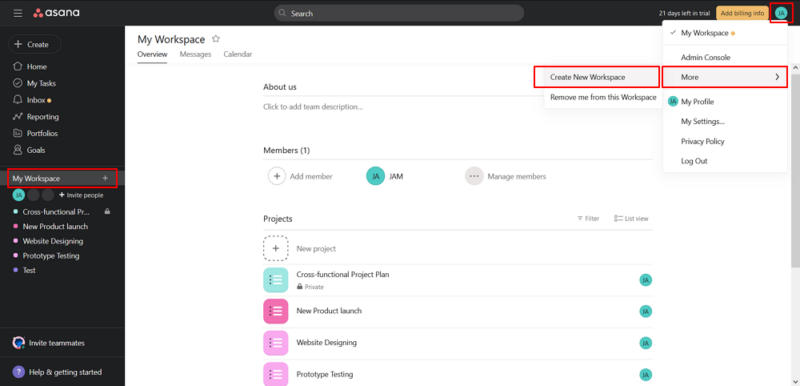
At the top level of the hierarchy are workspaces. Workspaces are the main folders that contain all the projects and tasks related to a particular area of a business. You can create multiple projects within the same workspace.
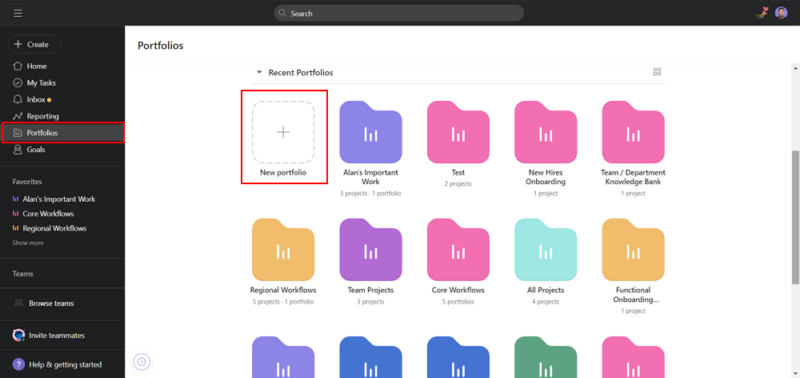
and ensure everyone is aligned with your goals.
Asana also allows you to create portfolios, which let you group projects and tasks of a similar nature in one place. Similar to subtasks, you can think of a portfolio as a sub-workspace, grouping multiple related projects away from the workspace’s full range. Portfolios can be accessed only with the Business or Enterprise plans.
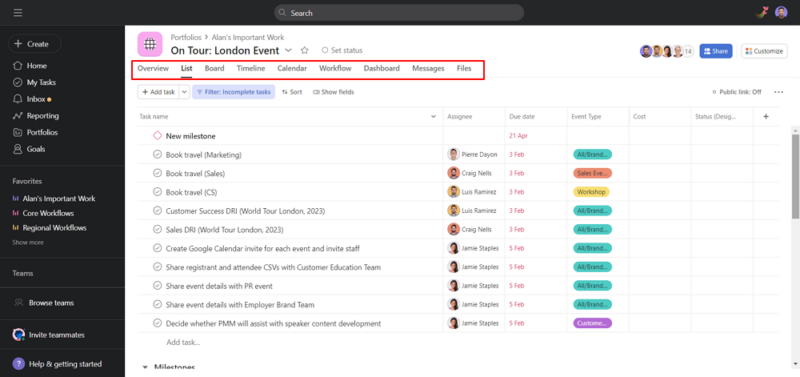
Projects are the next level in the hierarchy. Every task must be assigned to a project. You can create tasks and subtasks with custom fields and see them on visual boards like the calendar view and board view. You can also track task progress.
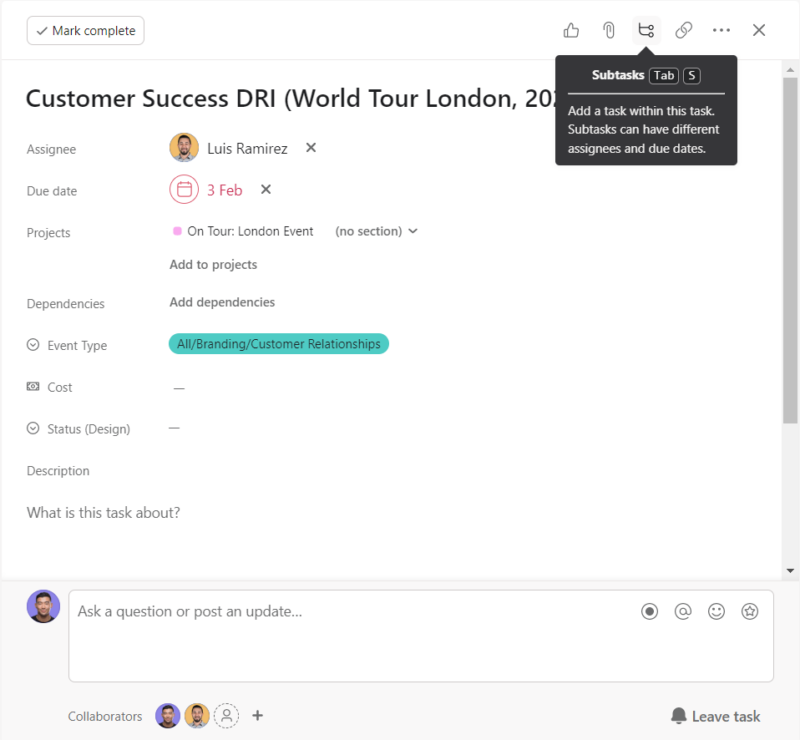
Asana tasks and subtasks are last in the hierarchy; the building blocks of all the upper levels. At the task and subtask level, you can use custom rules to trigger automations and manage larger projects with minimal manual effort. You can even create multiple subtasks with specific color codes and add attachments to provide necessary information.
Asana Quick Start Guide: Getting Set Up
Now that you know about the Asana hierarchy, we’ll show you some more Asana basics — how to get started with your new Asana account.
As a new user, you’ll get a free trial period of 30 days where you can access all Asana features. After the 30 days elapse, you can continue using the Personal plan or get a paid plan.
A Look Around Asana: Views
There are multiple views in Asana that illustrate your project tasks and progress. Every view serves a different purpose by providing you different angles with which to look at information. The availability of different views depends on the Asana plan you choose — check out the Asana pricing guide for more details.
For example, the overview and dashboard views help you grasp information at a quick glance, whereas the messages and files views let you communicate with your team and share documents. Let’s take a look at some of the other views that come in handy for tracking project progress.
- List View
The list view shows a comprehensive list of all tasks, which can be categorized into different sections and milestones. You can add tags, set a due date for the main task and set separate due dates for each subtask. You can also customize the fields you wish to see on your screen.
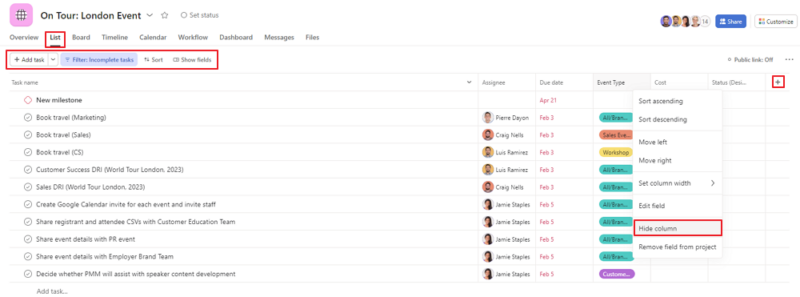
- Board View
In the board view, all tasks are displayed as cards on your screen, with the subtasks as checklists in their related card. Project phases are represented as columns: simply drag and drop cards from one column to another as the project progresses.
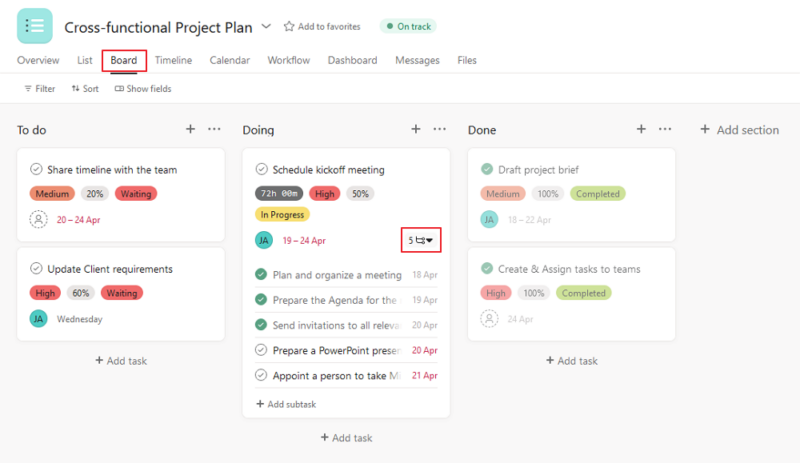
- Calendar and Timeline Views
The timeline view represents each task’s time consumption as a horizontal bar, while the calendar view displays the tasks on a calendar. Both are useful for enhanced scheduling and time management.
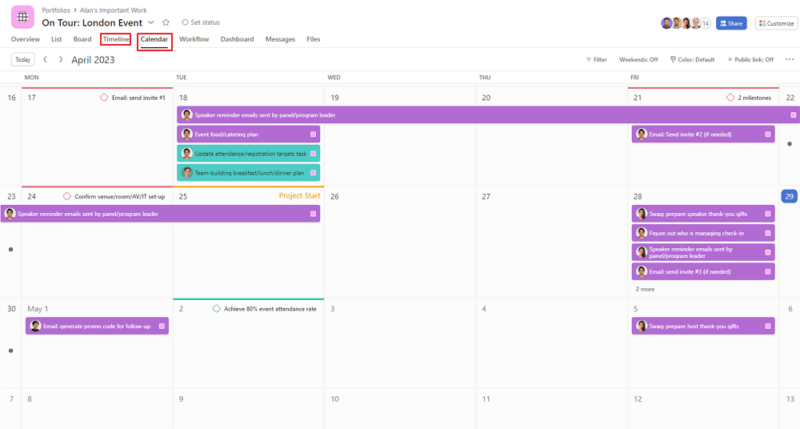
Asana Guide: How to Create a New Project
You can create and manage multiple projects simultaneously with Asana. Here’s how you can get started.
- Creating a New Project
To create a new project, click on the “+ create” button at the top-left side of your menu bar and select “project.” You can also click on the “+” icon to the right side of the “my workspace” section in the menu bar.

- Deciding the “How”
You can either start from scratch with a blank project, use a template from the Asana template library or import a spreadsheet. You’ve already seen how project templates work, during your account setup, so in this example we’ll start from scratch.
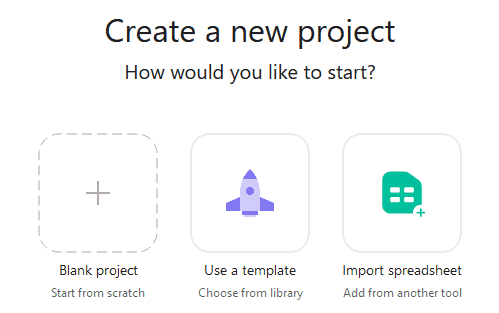
- Setting Up the New Project
You’ll be prompted to name your project (which is mandatory) and specify the project’s privacy level. Select your desired view and click on “continue.” The view you choose here will become the default view for the project, but you can access other views at any given time.
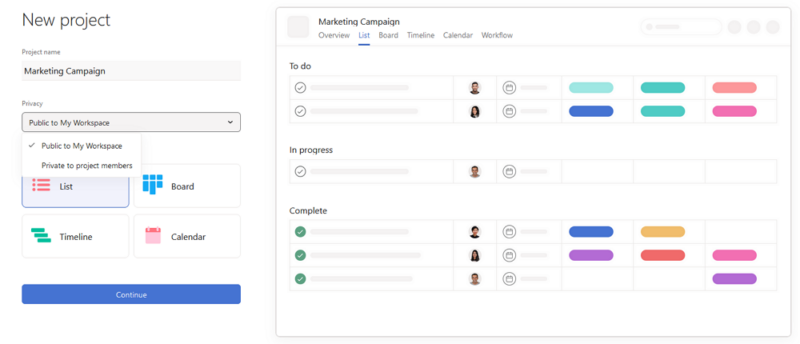
- Choosing Your First Activity
Select “start adding tasks” if you want to create and assign tasks right away. Select “share with teammates” to add collaborators or choose “set up workflow” to create different sections through which the tasks can progress in your project. When you’re done, click “go to project.”
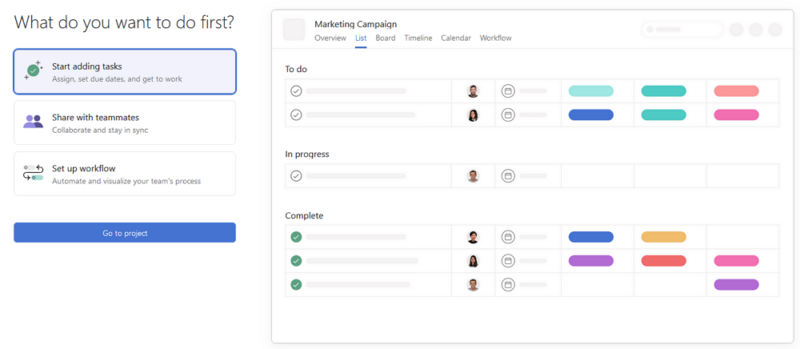
Asana Tutorial: How to Create, Organize & Find Tasks
Task management is one of the most important skills Asana can help you hone.
- Creating a Task
To create a task, click on the “+ create” button on the top-left menu bar and select “task.” Name the task and add an assignee. All other details, such as the task location, attached files, description and collaborators, are optional. Then select the project where you want to create the task and click “create task” at the bottom right of the task screen.
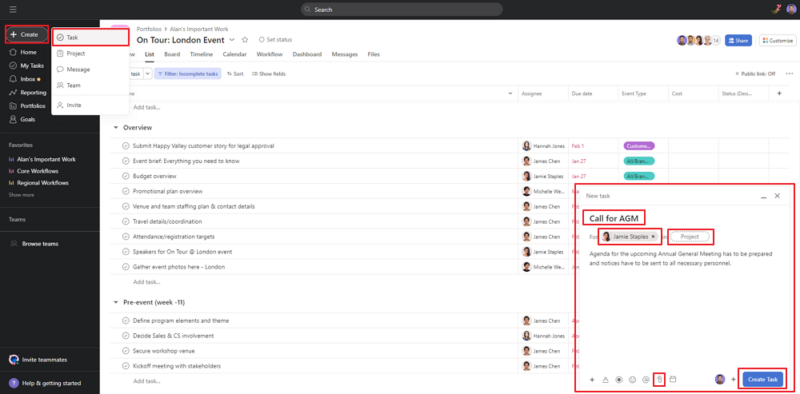
- Organizing Tasks
To organize or edit your task, click on the task, then the “…” button in the top-right corner of the task window. You can move the task to a different project or convert the task into a milestone, subtask or a new project entirely. You can also add tags, duplicate the task, create dependencies for each task or convert the task into a template for future use.
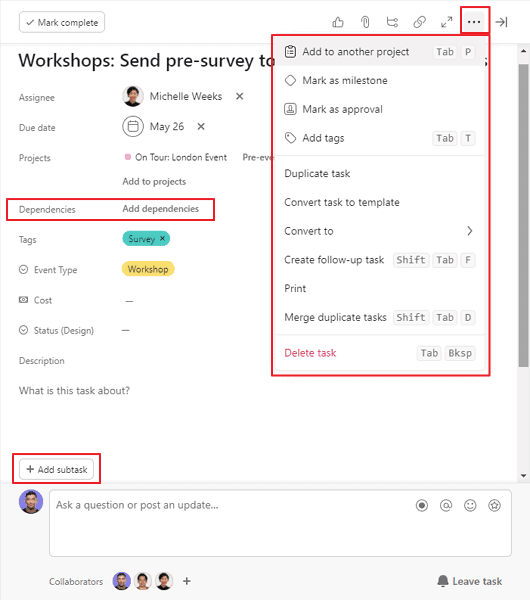
- Finding Tasks
Asana allows you to search all the tasks assigned to you. Click on “my tasks” at the menu bar on the left and choose a view to see all tasks on your screen. You can also search for a specific task from the search bar at the top.
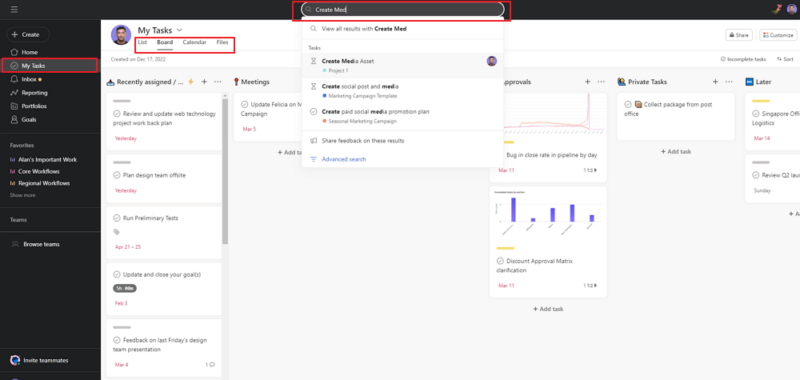
Asana Guide: How to Find Your Inbox
The Asana inbox is your personal space where you receive all messages and updates about tasks you’re associated with.
- Accessing Inbox
The inbox feeds show all your activities and updates. You can add likes and comments to each activity, or bookmark important updates by clicking on the bookmark icon. Click on the archive icon to archive the selected activity. You can also check all your sent messages in the “messages I’ve sent” tab.
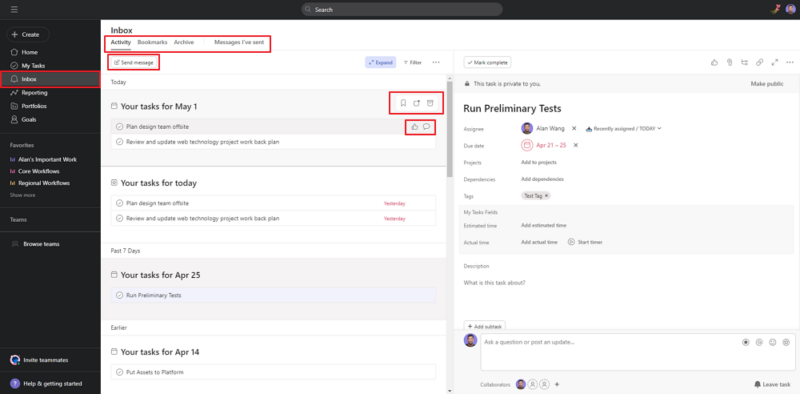
- Creating Follow-up Tasks
To add a follow-up task on any inbox activity, click on the encircled check icon OR click on the ellipsis icon in the top-right corner of the activity and select “create follow-up task.”
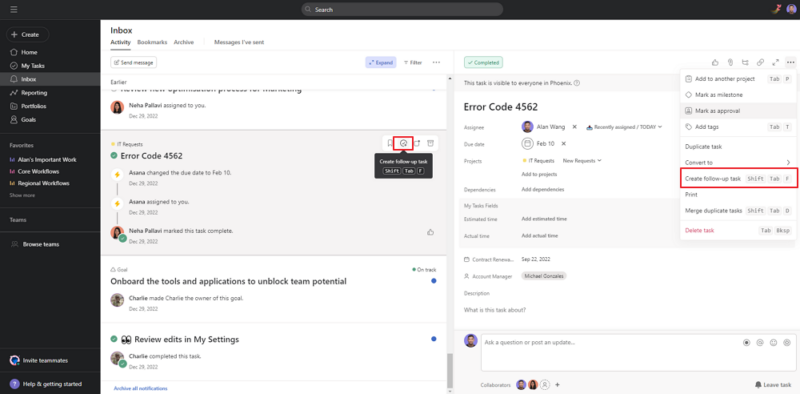
- Detail the Follow-up Task
A popup window will appear with the subject “follow up on ‘(Selected activity)’.” A link to said activity will be attached in the task description automatically. Add the necessary description, attach files from Google Drive or Dropbox, and click “create task.”
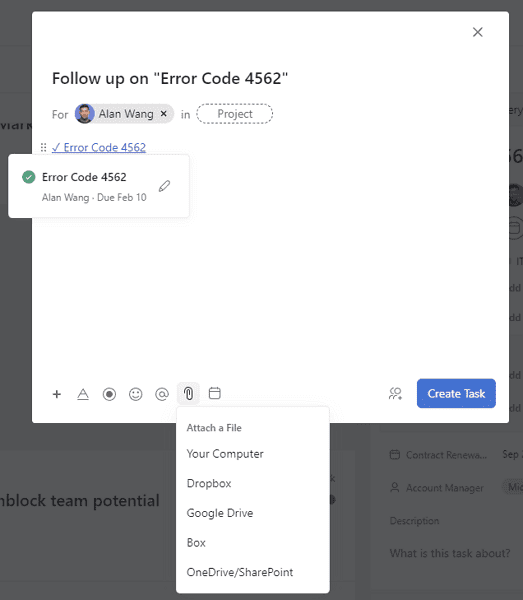
What Are Rules?

Rules are conditions you can set to trigger actions, reducing your manual work. You can access rules on the Starter, Advanced, Enterprise and Enterprise+ plans by clicking on “customize” at the top-right corner of your screen and clicking on the “rules” section. Click on “+ add rule” to create a rule.
What Are Integrations?

You can integrate your Asana account with your other work management tools. For example, you can learn how to create an Asana-Slack integration to connect all your team members on Slack, allowing you to assign Asana tasks with Slack messages.
Final Thoughts
We hope this Asana guide has covered all the basics you need to get started. You’ll get full access to all Asana features in its 30-day free trial, which will help you determine which plan is best for your business needs.
Take a moment to share your thoughts in the comment box below, or learn more about Asana by reading our Asana review. Did you find this guide helpful? Or were there key features and explanations you feel like we left out? As always, thank you for reading.
FAQ
-
Asana is a project management tool. You can use it to organize your tasks, get an overview of project progress and communicate with your team and other stakeholders.
-
The best way to learn to use Asana effectively is to sign up for a 30-day free trial. This will help you choose a plan based on your requirements.
The post Asana Tutorial 2024: Beginner’s Guide to Getting Started appeared first on Cloudwards.



